Music is the universal language
“Glory to God in the highest heaven, and on earth peace to those on whom his favor rests.” - Luke 2:14
Norse Guitar Feeds
The guitar gear used by Tony Iommi on Black Sabbath’s Heaven & Hell album

2025 has been a bittersweet time for Black Sabbath fans – seeing the band unite for one last time before Ozzy Osbourne’s tragic and unexpected passing just weeks later will go down as one of the most poignant moments in the history of rock.
- READ MORE: The guitar influences of Kurt Cobain
But such was the irreplaceable power of Ozzy as a frontman, it’s easy to forget that when he left the band in 1979 to build a legendary solo career peppered with some of the finest guitar-slingers around, Sabbath continued. If there’s an on-record bright spot in this post-Ozzy Black Sabbath period, it’s probably the immediate aftermath when Ronnie James Dio stepped in to front the band.
Heaven & Hell was the first album Sabbath recorded with Dio, released in 1980 and recorded across the previous year with the original Iommi/Ward/Butler dream team backing Dio up. After this record, Bill Ward would leave the band temporarily, and Geezer Butler would do likewise a few years later – kicking off a period of constant personnel upheaval for Sabbath that wouldn’t really settle until the original line-up reformed in 1997.
It’s understandably led to the post-Ozzy Sabbath records to not be well regarded, but Heaven & Hell is an exception. It features some of the best riffs and guitar sounds that Iommi had put on record since the early Sabbath records, this is what he used to make it.
Guitars: An SG Masterclass
Iommi’s main guitar for Heaven and Hell was the SG-type that is most commonly associated with him today, an instrument he lovingly refers to as “Old Boy”. Old Boy was originally built in 1975 as a backup to another custom SG-style guitar that John Birch had built for Iommi. Old Boy was built by John Diggins, who worked for John Birch, and had been asked to tour the US as a guitar tech for Tony. The guitar was meant to serve as not only a backup guitar, but as a platform for him to experiment with different pickups while on tour.
Due to time constraints before leaving for the tour, Old Boy was built by Diggins at home on his kitchen counter over the course of only a week or two. Due to the rush to get it done before the US tour, the finish didn’t have enough time to cure, which led to its distressed look – it was also later left in a car in Brazil on a very hot day and the finish bubbled up, resulting in the look we see today.
The pickups were swapped out a fair amount in the early days before settling on the pickups Iommi liked best. They are, of course, John Diggins custom pickups – the neck was modeled after a John Birch Magnum X – even using a John Birch casing. The bridge was a total custom Diggins pickup. All of Tony’s guitars have the bridge tone pot disconnected. The guitar, at one time had a booster circuit, which was soon removed. Old Boy also features an additional output jack which served as a low impedance output for recording purposes. That was later disconnected. The guitar features cross inlays and a zero fret.
Old Boy was used on overdubs for Heaven and Hell and was the main weapon of choice on every album after that. Diggins built Tony another SG in 1981 as a spare to Old Boy. It featured dual rail humbuckers, and what many believe was a Kahler 2300 tremolo.
So, what guitar was used for the main tracks? The most likely culprit was a cherry red customized left-handed Gibson SG that Iommi dubbed “Monkey”. Monkey was used from the very first album through the classic era lineup. Old Boy was made as a successor to Monkey, but it seems likely that Tony was still using Monkey in the studio during the initial sessions for Heaven and Hell. The neck pickup in that guitar is a John Birch custom pickup and the bridge is a Gibson P-90 that was fitted into a metal casing, again, by John Birch. These are the most likely guitars used on the album.
Amplifiers
Iommi’s amplifiers of choice during that era, and much of his career, were the Laney Supergroups. The folks at Laney seem to recall Iommi getting some of the early prototypes, but we can’t confirm that those amps made it to Iommi prior to the recording of Heaven and Hell. The Supergroup was generally used in conjunction with a Dallas Arbiter Rangemaster Treble Booster, which drove the amps a bit harder on the front end.
However, Iommi claimed in an interview with Vintage Guitar Magazine that for Heaven and Hell, he used a modded Marshall, specifically a 1959 model, which eliminated the need for a Treble Boost, as he stated in the interview:
“On Heaven and Hell, I used a Marshall [model 1959 Super Lead], and effects in the studio were a delay, certainly, on the solo bit for Heaven and Hell. … I had John ‘Dawk’ Stillwell come in – he used to build Ritchie Blackmore’s amps – and he lived with us while we were writing and recording in Miami. We had six Marshalls that he rebuilt with an extra stage, so they were a bit more potent than a regular Marshall. He’d done away with the treble booster I had forever. I was really not happy about that (laughs). He’d thrown it away, and I didn’t know. He said, ‘You don’t need that. You just go straight into the amp.’ Which is what I did.”
The addition of an extra preamp tube as a gain stage was not an uncommon modification to those Marshall amplifiers in that era. Jose Arredondo was well known for performing this modification. While Arredondo performed the mod for the rockstars on the west coast, Stillwell performed the same mod for British rockers like Iommi and Blackmore (he also worked for Richie Sambora). There is no evidence that the two amp gurus ever met, but the modifications they did were very similar, with a common objective.
Elsewhere in the Vintage Guitar interview, Iommi said the only effects he used on the album were a chorus, a delay, and a wah, although he didn’t go into detail about what models he used. However, Tony has historically been partial to the Tychobrahe Parapedal for the wah, which debuted in the mid-1970s.
Legacy
The album Heaven and Hell remains a gem in the Black Sabbath catalogue, despite not featuring the classic lineup. The album remained a great platform for Tony Iommi to further showcase his brilliant guitar wizardry, this time amidst the very different vocal style of Ronnie James Dio. It added an element of depth and variety to what we now know as the Black Sabbath sound.
The post The guitar gear used by Tony Iommi on Black Sabbath’s Heaven & Hell album appeared first on Guitar.com | All Things Guitar.
Orange Amps Launches King Comp
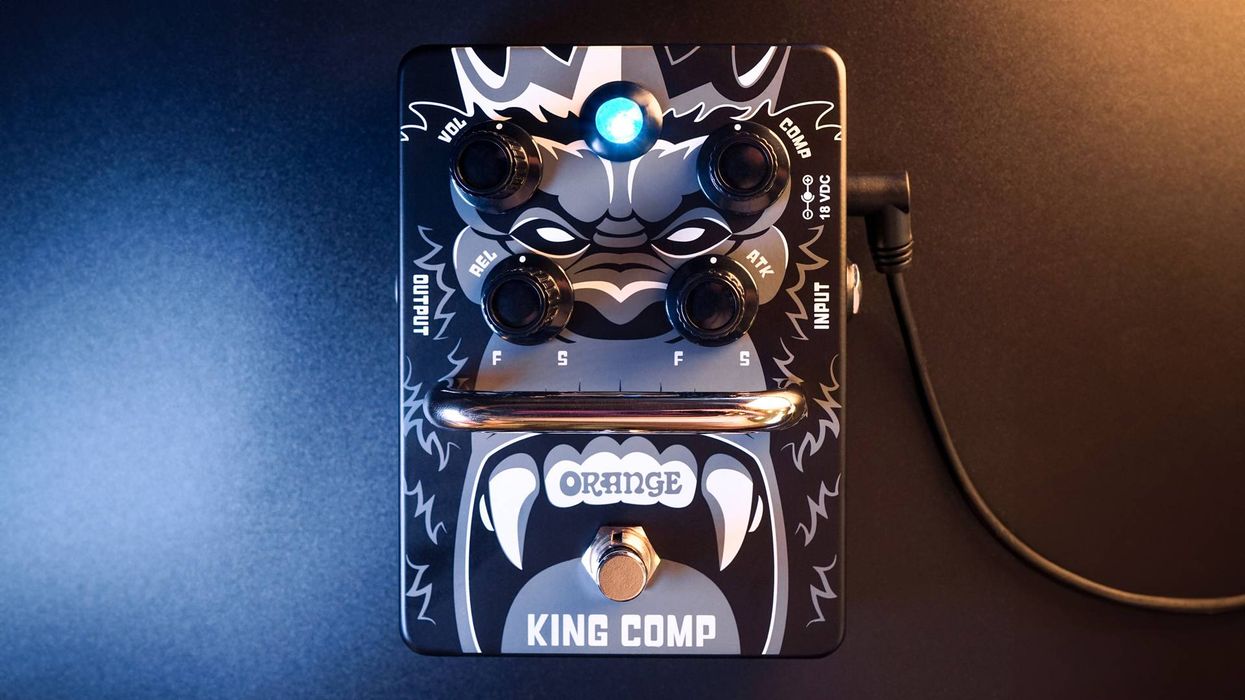
The new Orange Amps King Comp is a super low noise Class A VCA compressor pedal with 18V DC power supply for extra headroom and subtle envelope shaping control. It brings studio style compression dynamics to any pedalboard and offers a warm musical response with an exceptionally low noise floor.
Developed to meet the ever-evolving musical needs of guitarists and bassists, the King Comp pedal enhances sound by adding sustain, snap and sparkle rather than flattening it, offering smooth, musical, pro-level compression with real character.
The super useful dual attack and release knobs mean users can set how quickly the compression kicks in and shape every note they play. The versatile attack control allows anything from understated tightening to pronounced pogoing bounce to be dialled in. At the same time the equally adaptable release control gives long-lasting sustain for notes and chords that can go on for miles. Plus, there is also visual feedback of any compression applied when the King Comp’s onboard LED switches from blue to pink.
At the heart of the King Comp pedal is the Class A VCA compression circuit that delivers precision dynamics with a warm, natural feel. There is also a high-quality buffered bypass to ensure signals stay strong and consistent, even when the pedal is off. The buffer maintains clarity, keeping sound punchy and defined and makes the King Comp reliable as an always-on part of any setup.
Running with the external 18V DC supply maximises the King Comp’s dynamic range and reduces compression artefacts so the pedal delivers the most transparent version of any instrument's tone, making it especially useful with hot pickups, basses and more complex pedalboards.
The King Comp pedal offers precise dynamic control with a musical feel that responds like a great amp. To find out more please go to www.orangeamps.com.
Stompboxtober 2025: MXR
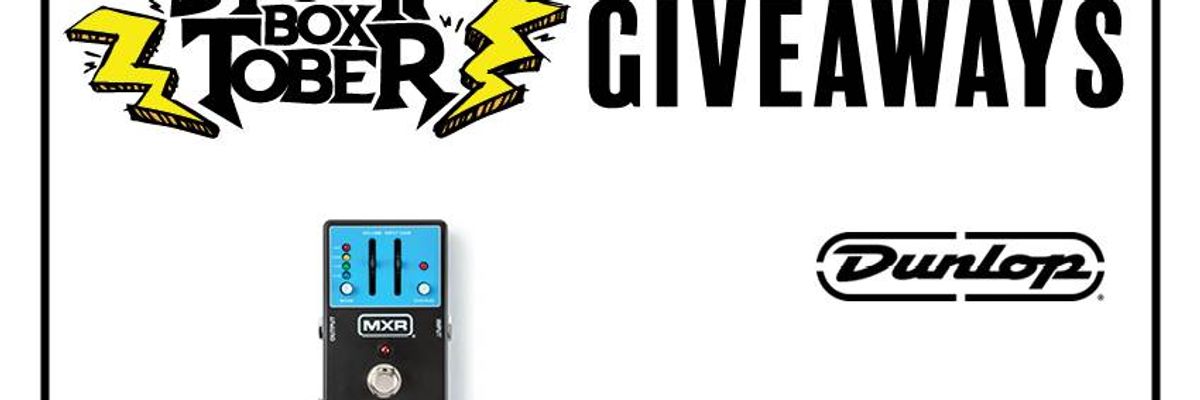
Today’s giveaway is live! Win the legendary MXR Rockman X100 — a pedal‑sized recreation of the iconic tone machine created by Tom Scholz (of Boston) that defined the sound of ’80s arena rock. Enter now for your chance to win!
Stompboxtober 2025 - Win Pedals All Month Long!
MXR® ROCKMAN® X100™ ANALOG TONE PROCESSOR
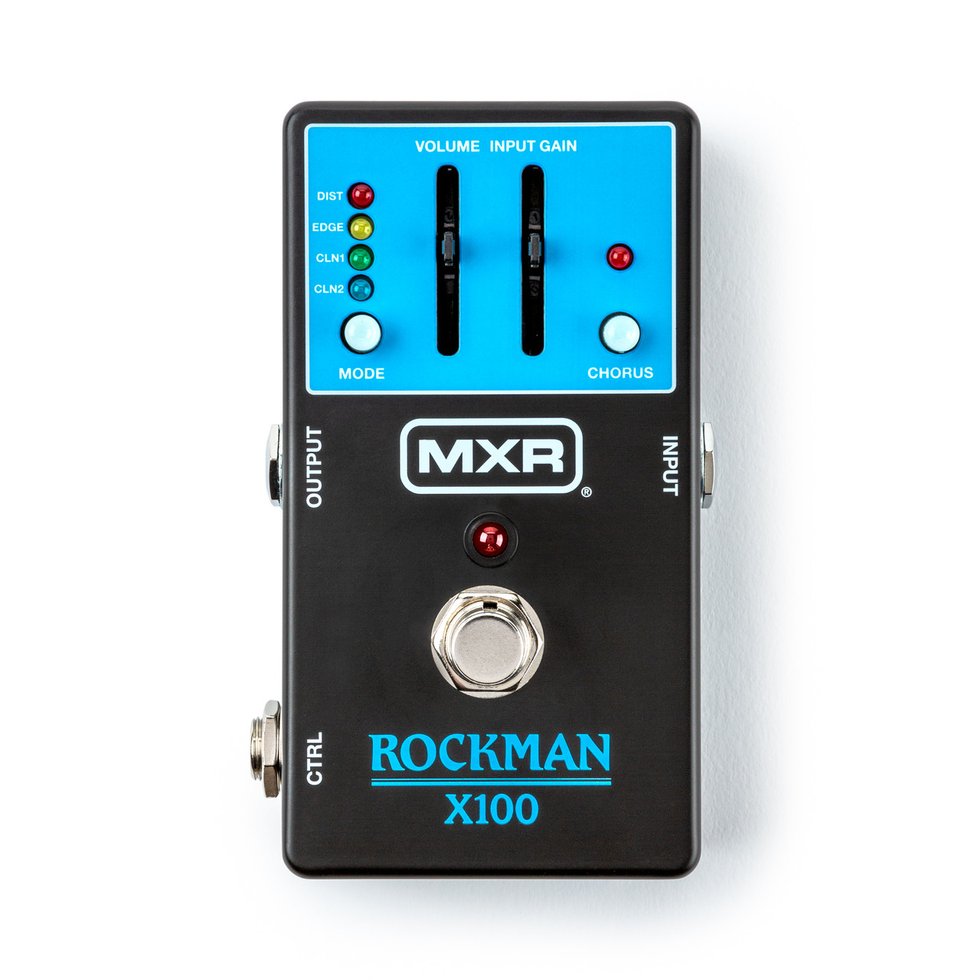
The MXR Rockman X100 Analog Tone Processor revives the signature sonic character of Tom Scholz’s celebrated headphone amp and signal processor in pedal form, offering crystalline cleans, crunchy harmonics, and shimmering modulation.
This pedal requires 9 volts and can be powered by a Dunlop ECB003 9-volt adapter or an MXR® Brick™ Series power supply.

MXR Rockman X100 Preamp Pedal
Rig Rundown: Starcrawler
Henri and Bill Cash, the brotherly guitar duo behind Los Angeles glam-rock band Starcrawler, linked with PG’s John Bohlinger before their gig at the Pinnacle in Nashville to show off some rose-colored rock tools. Check out highlights of their dazzling setups below, and tune into our full Rig Rundown to scope the full details.
Brought to you by D’Addario.
Pink Pony Club
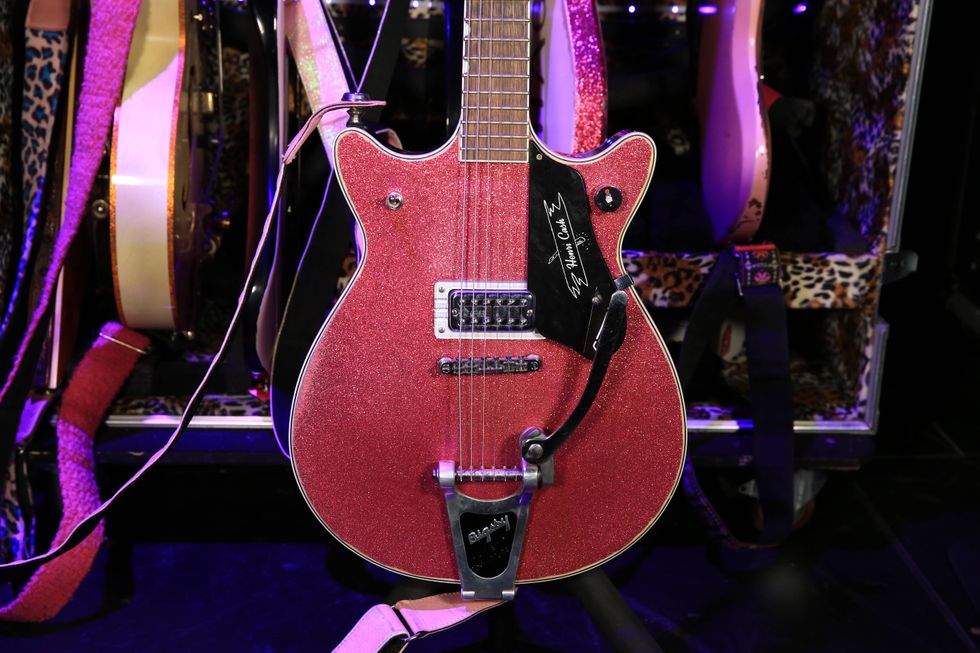
This China-made Gretsch Electromatic Double Jet has just a single TV Jones Power’Tron Plus pickup, but beneath the hood, it’s also got a Rangemaster-style treble-boost circuit (as does another 3-string Electromatic that Henri plays). Henri traced out and applied sparkle-pink paper to give the guitar its memorable finish.
This pink powerhouse is tuned to open G.
Flying Bigsby
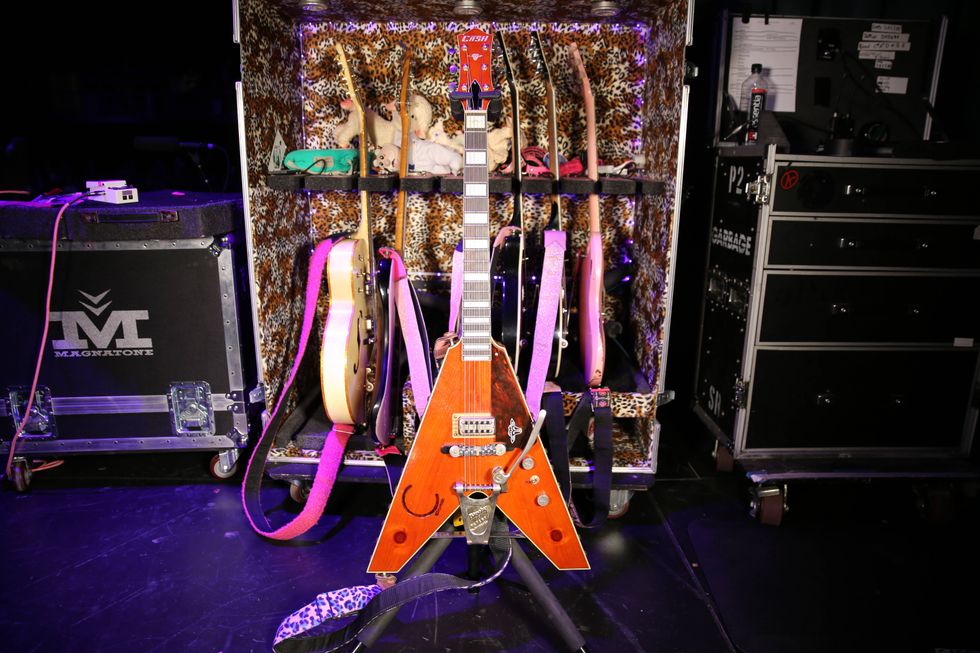
Daniel Slusser of Slusser Guitars in San Luis Obispo, California, built this custom V-style according to Henri’s requests, borrowing from a design by Japanese builder Saraso Ju. It’s made from pine from Home Depot, bound with leather, and outfitted with a Bigsby and a Filter’Tron pickup for Gretsch groove.
Triple Threat
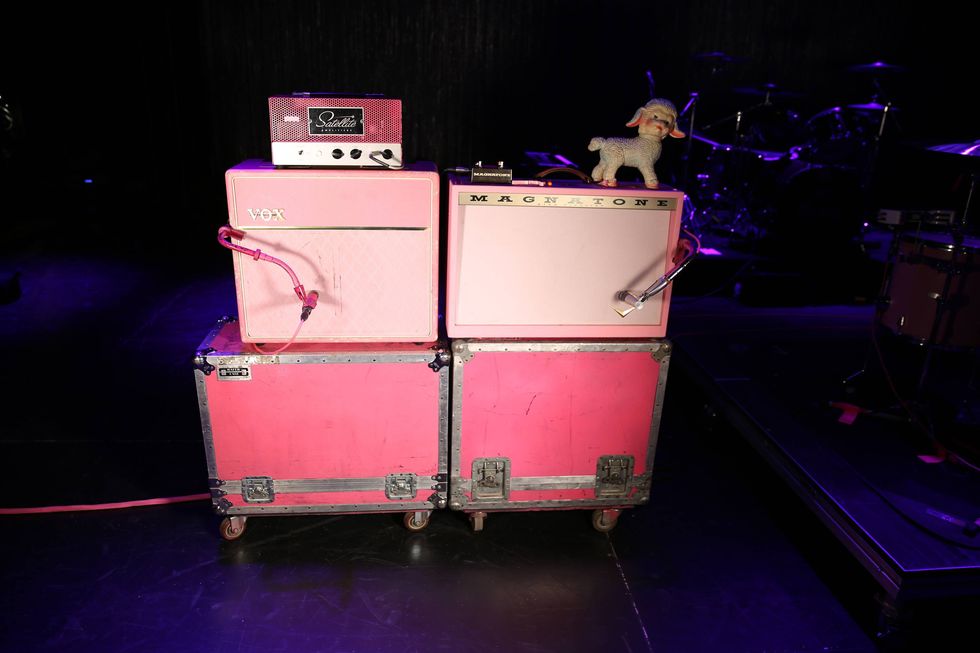
Cash runs his dry signal to either this Satellite Amplifiers Neutron head or Vox AC15 combo, and his effects go to the Magnatone Twilighter Stereo on the right.
Henri Cash’s Pedalboard
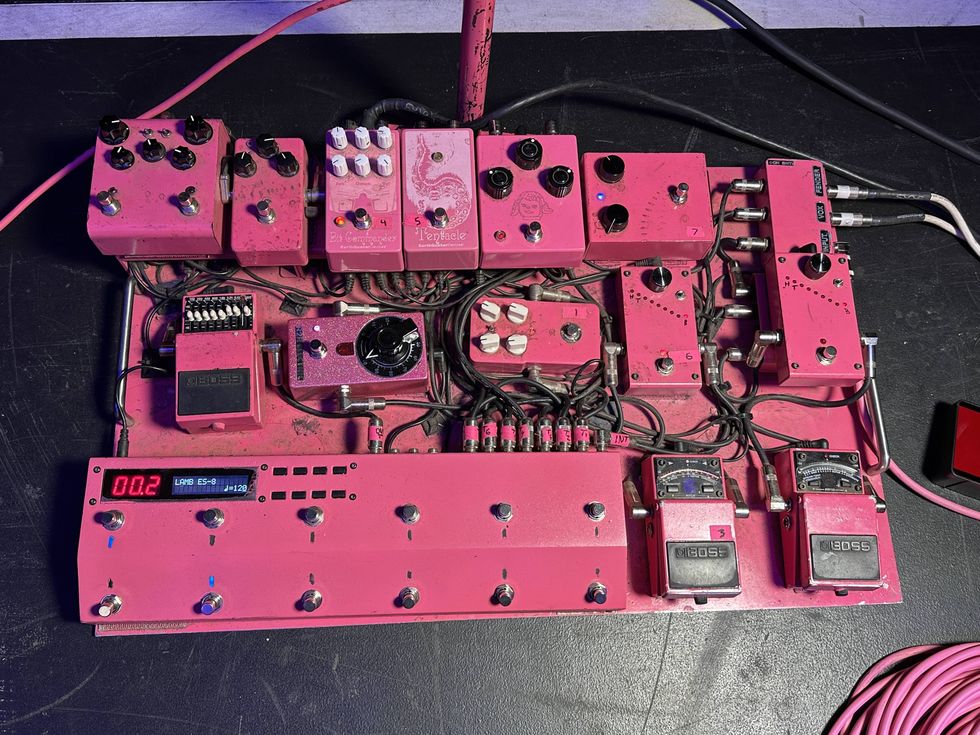
After a pair of Boss TU-3s and a Boss ES-8 switcher, Henri’s board has a pair of DigiTech Drops, TC Electronic Shaker, R2R Electric Preamp, Boss GE-7, MXR Carbon Copy, Way Huge Red Llama, custom “Lamb’s Head” fuzz designed by Henri and Desi Scaglione, EarthQuaker Devices Tentacle, EQD Bit Commander, and Strymon Flint. A Lehle P-Split sends his signal to either the Neutron/AC15 and the Magnatone.
Tweaked Tele
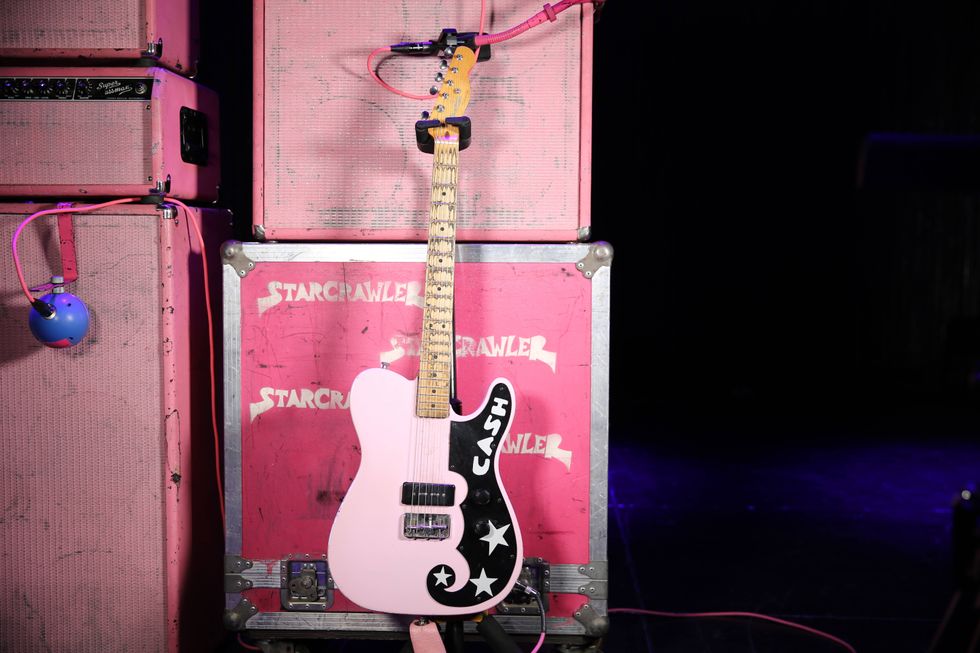
Bill’s main axe is this heavily modified Fender Noventa Tele, with a Curtis Novak P-90 and a Glaser B-bender system.
Slide Away
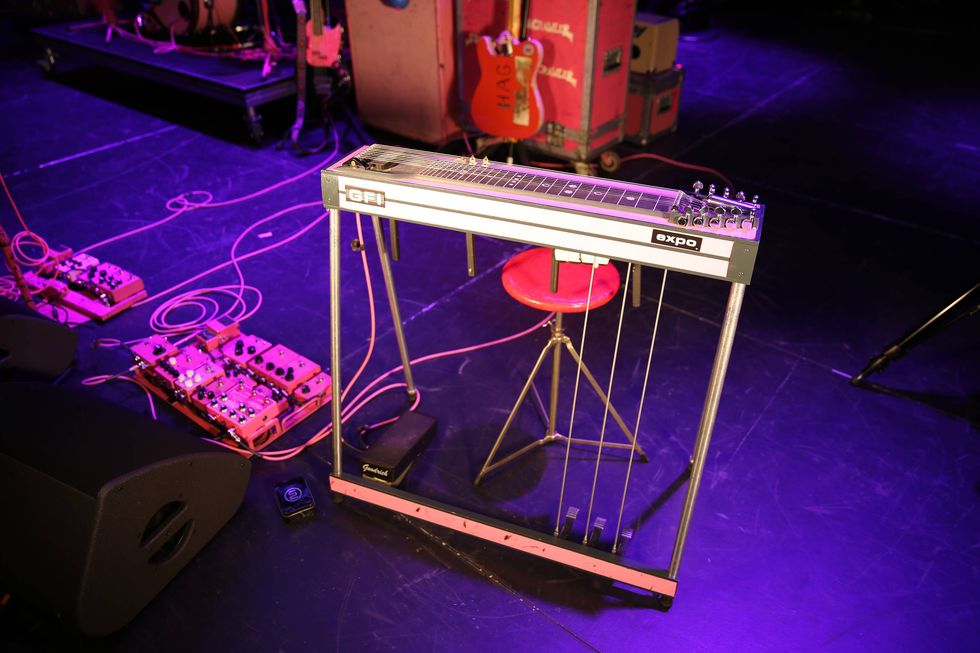
For slide parts, Bill uses this GFI Expo pedal steel.
Souped-Up Super
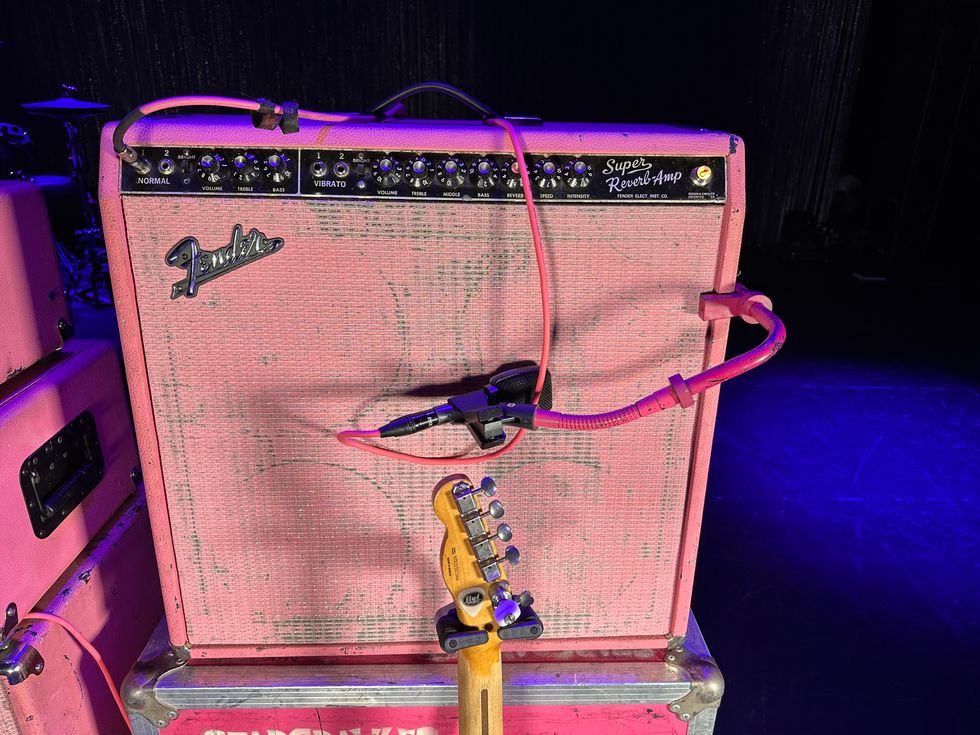
Bill plays through this modded Fender Super Reverb Reissue. The tweaks included inserting a 5E3-tweed-Deluxe-Style circuit in first channel that switches to a handwired Super Reverb-style circuit in the second channel so he can use the tweed channel on guitar and clean black-panel tone on pedal steel. It was inspired by a mod he saw Colleen Fazio did to a friend's Bassman where she changed the first and second channel to be channel switching as well.
Bill Cash’s Pedalboard
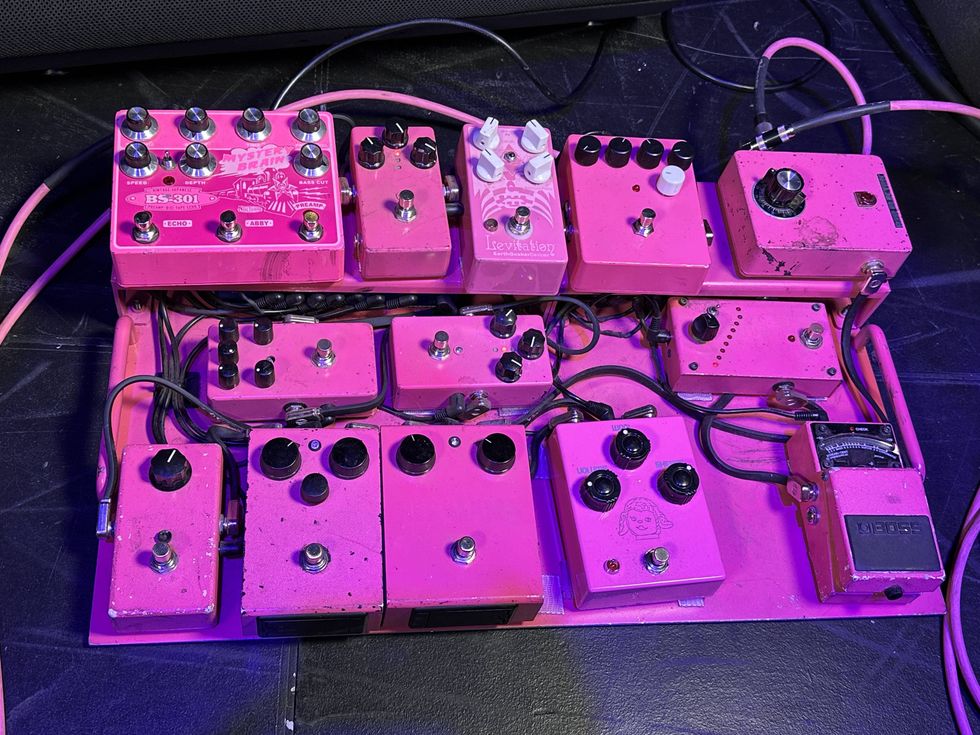
On his sprayed-painted pedalboard, Bill runs a Boss TU-3, custom “Lamb’s Head” fuzz by Henri and Desi Scaglione, Way Huge Red Llama, Way Huge Conquistador, MXR Micro Amp, DigiTech Drop, Catalinbread Belle Epoch, MXR Reverb, MXR Tremolo, EarthQuaker Devices Levitation, Electro-Harmonix C9, and a Nocturne Brain Mystery Brain.

Gretsch Electromatic Double Jet
TV Jones Power'Tron Plus Pickup
EarthQuaker Devices Bit Commander
Living in Purgatory with Big Thief

In his 2017 book The Order of Time, Italian theoretical physicist Carlo Rovelli looks to Saint Augustine to demystify the question of how it’s possible to experience music if we are physically rooted to the present—while music, of course, happens over seconds, minutes, hours. “It is possible, Augustine observes, because our consciousness is based on memory and anticipation,” Rovelli writes. “A hymn, a song, is in some way present in our minds in a unified form, held together by something—that which we take time to be. And hence this is what time is: It is entirely in the present, in our minds, as memory and anticipation.”
The idea of this middle place poignantly haunts Brooklyn indie-rock band Big Thief's latest record, Double Infinity. In a press release, the band noted that the album title refers to the idea of the “purgatory created by the human brain, always looking to the past or future, between the things we’ve lost and the things we want, between desire and regret.” There are few lyricists in recent memory writing as movingly about this experience—that of looking back, of time passing, moving, receding and stretching out in front of us—as Adrianne Lenker.
“Without this idea of time there’d be no grandmothers and grandfathers, or children,” Lenker says over the phone from Mexico City with bandmate Buck Meek. “There’d be no difference between any stages of life. It’s so wrapped up in reality as we know it, or at least this perceived reality or dream. I feel like it’s such an interesting idea, because it’s a thing that we live with, and the parade leads to the same place for everybody. It’s all wrapped up in death and birth and all of the things we experience along the way, like longing and loss and grief and joy. While you’re falling in love with someone, you’re also perceiving the end of that thing because of time—because of the inevitability of its passing.”
“While you’re falling in love with someone, you’re also perceiving the end of that thing because of time—because of the inevitability of its passing.”—Adrianna LenkerOn one hand, the nature of music makes it a simple task to create compositions concerned with time, as all music occurs over a duration of time. But what does it actually sound like to fully realize that? As a group, and this time with a cohort of studio collaborators, Big Thief’s sonic treatment of these themes captures a specific duality of being: its miraculousness and mundanity. Double Infinity’s production is low-key and handhewn, with rhythms and repetition building feelings that oscillate between grounded and hypnotic, and flourishes of the transcendental—be it blasts of guitar sorcery (“Words”) or ambient icon Laraaji’s wordless vocal flights (“Grandmother”). The result is Big Thief’s most fluid, breathing, flowing record to date—and, for Lenker, an evolution of what the term “rock ’n’ roll” can mean.
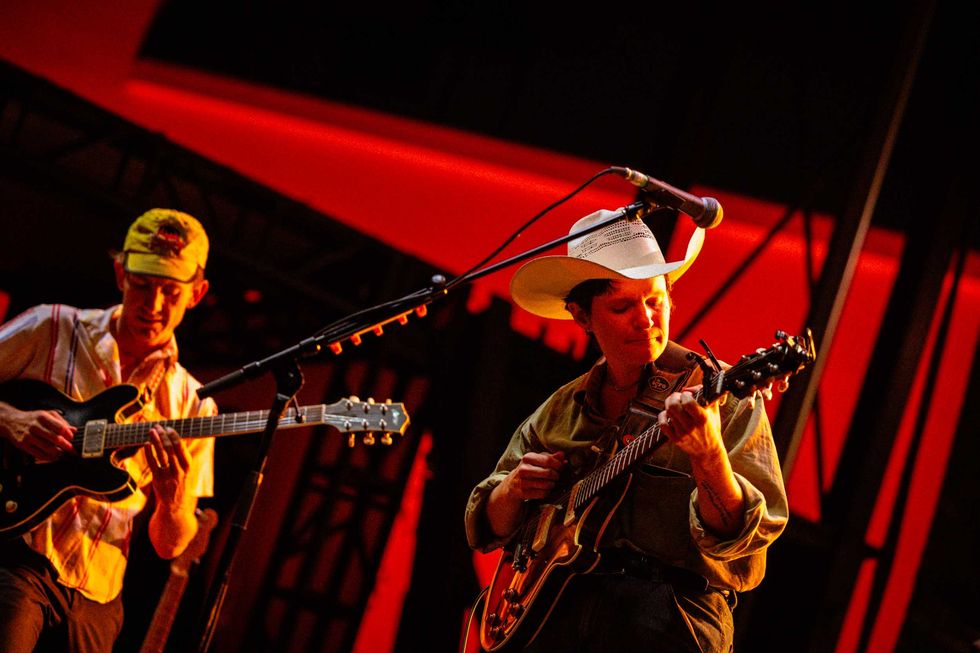
“It just immediately makes me think about the bedrock of the earth, and the rolling of the waters and the winds and ethers,” Lenker says. “I think about that dance between what is rooted and solid-feeling and what is fluid and liquid. [Rock ’n’ roll] really needs both.”
Creating music that captures that dance is made easier by a few special tools. Both Lenker and Meek gush over their friends and luthiers Aaron Huff (at Collings Guitars) and Flip Scipio. Huff—“a true Jedi of good in the guitar world,” Lenker says—spent four years building Lenker’s acoustic guitar in his free time, and gifted it to her on the day of a solar eclipse, the same day she met Laraaji. “It’s basically meant for the way I play—open tunings and fingerpicking—and it sounds like a grand piano. It’s so special,” Lenker says.
Meek says two of Huff’s creations at Collings—the 71 and the Ladybird—are in heavy rotation in his quiver. He uses the latter for jazzier songs. Meek and Lenker both also have their own Flipperkasters, custom models made by Scipio. “I’ve never connected with an electric guitar so deeply until he put that in my hand,” Lenker says.
“The guitars we really love are the ones that have been mediums for friendship, or conversations with people in our lives that have really influenced us,” Meek says. “The instrument is kind of just a vessel for that.”
On Double Infinity the guitar, along with the rest of the instrumentation, acts as a conduit for connection. With 10 people improvising arrangements in the studio, the aforementioned fluidity builds from individual players’ intuitive responses to the aggregate. For Meek, that led to a lot of simplifying and repeating lines, offering room to other instruments, and creating an environment where rhythm feels like the element around which everything orbits.
“The guitars we really love are the ones that have been mediums for friendship.”—Buck Meek
“Playing in this band has definitely encouraged me to tap into my intuition more, just through watching Adrianne play and write songs so intuitively,” Meek says about his experience unlearning more academic modes of improvising. “It’s a process of letting go of all of that music theory and just trusting that the language is in there somewhere, and reconnecting with a more somatic approach to improvisation.”
Adrianne Lenker’s Gear
Guitars
Flip Scipio Flipperkaster (sunburst)
Flip Scipio Flipperkaster (woodgrain/gold)
Collings SoCo (green)
Collings SoCo (brown)
Huff acoustic
Amps
1960 Fender Tweed Deluxe
Two-Rock Vintage Deluxe 35-watt head and cab
Effects
Boss DC-2W Dimension C
Mikel Patrick Avery Zeffle Box Type1
Strymon El Capistan
Analog Man Prince of Tone
The GTO Pedal (modded Klon Centaur clone made by Ben Gram, Adrianne's guitar tech)
Lehle amp switcher
Peterson StroboStomp
Strings & Picks
D’Addario EJ16 acoustic strings (.012–.053)
D’Addario NYXL 1252W strings (.012–.052)
D’Addario NYXL Custom Nickel/Steel Set (.011–.015–.018–.028–.038–.054)
G7th Performance 3 ART capos
Kyser capos
Fred Kelly Medium Slick Picks
2- and 4-sided nail files
Buck Meek’s Gear
Guitars and Basses
Collings I-35
Collings Ladybird
Collings 71 M
Flip Scipio Flipperkaster
Guitar Mill partscaster (Throbak pickups, Callaham Guitars hardware)
1954 Gibson Les Paul Custom Staple Pickup Reissue
Bayard acoustic
Amps
1957 Fender Super
1955 Fender Champ 5E1
Effects
Analog Man Beano Boost
Charlie Pedals Troubadour
Lehle volume pedal
Soundgas 636P
Gamechanger Plus Pedal
Mikel Patrick Avery Brackle Box
EHX Attack Decay
EHX Nano POG
Walrus Audio Julia
Fairfield Circuitry Meet Maude
Strymon Flint
Strings & Picks
Fender medium picks
Curt Mangan strings (.010–.046)
This all requires a concentration on being where you are. Settling into the groove, let’s say. The purgatory between Big Thief’s double infinities is, itself, an endlessness. We comprehend its power and depth when we’re jolted into truly feeling it; in moments of profound loss or acute pain or consuming love, past and future briefly cease to exist. If one listens close enough and thoughtfully enough, the effect of Double Infinity, its rolling rhythms and loose drip, is one of tapping into the moment—freedom from the dissolving before and the unknowable after.
“The thing that pushes me to keep making and playing music is that I run into my own limitations all the time, and I just want to get a little bit more free with each album we make.”—Adrianne Lenker
“I feel like the thing that pushes me to keep making and playing music is that I run into my own limitations all the time, and I just want to get a little bit more free with each album we make,” Lenker says. “And I feel like people could be like, ‘What are you doing? It sounds so loosey goosey and wide open,’ and it's like—”
“That’s the very thing I’m proud of,” Meek adds.
“Yeah, that’s great,” Lenker continues. “To be honest, I think I had more fun in that session than I ever have before, because there was this big, open feeling of music and we were listening to all these other people playing with us. It wasn’t about shaping our wants and desires perfectly into the shape we think it should be with our minds. It was about just being there for that experience.”
“People who say rock is dead just wanna listen to Kiss”: Why Wolfgang Van Halen believes guitar music is still thriving

Is guitar music dead? It’s a question which lingers on some people’s minds – generally those outside the still-thriving guitar world, or, as Wolfgang Van Halen says, those whose musical repertoires consist of rock bands past their heyday.
Reflecting on recent comments made by Lzzy Hale – in which she said Wolfgang and his band Mammoth were going to be the ones to “save rock and roll” – the multi-instrumentalist tells Ultimate Guitar says Hale’s comments were “a very sweet gesture”, but that he doesn’t think rock needs saving at all.
- READ MORE: Guitar.com cover star Mateus Asato releases his first official single Cryin’: “It’s been 10 years of identity crises about who I am in terms of music”
“Lzzy is wonderful,” he says. “I love her very much. She’s awesome and a badass in her own right. But I don’t think rock needs saving.
“I think there’s plenty of awesome rock that’s happening right now. I think because it might not be in the forefront – and pop is always sort of at the top – but I don’t know. I don’t think rock needs saving.
“Rock isn’t dead. Rock is very much alive. I think anybody who says that is maybe just looking in the wrong place, or isn’t open enough to listening to new stuff. At the end of the day the people say rock is dead just wanna listen to Kiss, and that’s about it.”
Wolfgang is certainly right that what you might call ‘legacy bands’ often dominate the conversation surrounding modern-day rock and roll, especially among those not deeply connected to the genre. Ask a music fan who only occasionally dabbles in rock music who their favourite bands are, and you’ll often be met with the likes of ‘Kiss, AC/DC or Guns N’ Roses,’ for example.
It could also be argued that there’s a human tendency to become set in our ways as we age, often resorting back to the stuff we know we like.
Most people who would consider themselves rock fans first and foremost would probably agree with Wolfgang that the genre is very much alive, so with the younger rock scene which is very much still verdant, is it perhaps down to a marketing problem in recruiting outsiders into the genre?
Despite his ancestry as the son of Eddie Van Halen, Wolfgang has managed to carve out a musical niche all his own. His band Mammoth are gearing up to release their third album The End later this week, following positive reception received for his previous two albums Mammoth (2021) and Mammoth II (2023).
Speaking to Guitar.com in a recent interview, Wolfgang recalled the time he realised that his dad was actually a pretty big deal.
“There was a benefit I played in fourth grade where I played drums and my dad played guitar. I remember, we went out to the car afterwards and some guy came up and asked him to sign something,” he remembered.
“He left, then he put on a different shirt and came back. I think – in moments like that, seeing that sort of desperation – I was like, ‘Oh, yeah, my dad’s probably a big deal, huh?’”
Mammoth’s The End is out Friday 24 October via BMG.
The post “People who say rock is dead just wanna listen to Kiss”: Why Wolfgang Van Halen believes guitar music is still thriving appeared first on Guitar.com | All Things Guitar.
Taj Mahal and Keb’ Mo’ Reunite to Channel Tradition, Tone, and Spirit into a Sound All Their Own
Guitar.com cover star Mateus Asato releases his first official single Cryin’: “It’s been 10 years of identity crises about who I am in terms of music”

After years of viral Instagram performances and touring with pop superstars like Bruno Mars, Tori Kelly, and Jessie J, Mateus Asato has released his first official single, Cryin’, marking the start of his solo journey.
Despite millions of followers and years in the sideman spotlight, the Brazilian guitarist had yet to release a solo track – until now. Cryin’ arrives ahead of his forthcoming debut album, set for early 2026.
“It’s been 10 years of a lot of doubts and questions… and some identity crises about who I am in terms of music,” Asato says of his journey in the May/June issue of Guitar magazine. “The album is definitely a journey through all the sides of Mateus. The Mateus who’s a sideman, Mateus as the Instagram boy, and then the Mateus that got more mature over the years. Who developed a different vision regarding music, regarding how I see guitar.”
The song itself was a long time in the making. Asato began drafting Cryin’ in February 2020, during a period of global uncertainty, and finally completed it four years later, in February 2024, just a week before his wedding.
“Cryin’ is my emotional celebration of life — the first act of being human and the sound of joy, fear, and love all at once,” he says. “It’s a reminder that life is full of emotions, vulnerability, and movement, and you’re free to feel it your own way.”
Looking back on his career now, Asato admits that making the leap from stable pop gigs to solo artistry wasn’t easy.
“Trading the stability and the status of playing for a pop star to start walking on my own steps was a very tough decision, and that takes time,” he tells Guitar World. “I was able to give myself a proper season of rest. [It] cleared the path for me to start this first season of my solo career with a very great feeling.”
Listen to Cryin’ below.
The post Guitar.com cover star Mateus Asato releases his first official single Cryin’: “It’s been 10 years of identity crises about who I am in terms of music” appeared first on Guitar.com | All Things Guitar.
“I owe not just an artistic debt to him, but a life debt to him”: Tom Morello on the genius of Ace Frehley

Tom Morello has paid tribute to Ace Frehley, describing the late Kiss guitarist as not just a musical inspiration but someone to whom he owes a “life debt”.
Speaking on a recent episode of SiriusXM’s Trunk Nation With Eddie Trunk, Morello reflects on his first encounter with Kiss and his lifelong admiration for the band’s original guitarist, who passed away last week at the age of 74.
- READ MORE: Ace Frehley 1951-2025: Guitar community mourns the death of Kiss’s trailblazing founding guitarist
“[Ace] was my first guitar hero. Kiss was the band that made me love rock and roll, and he was the lead guitar player of that band,” says the Rage Against The Machine guitarist [via Blabbermouth].
“I mean, without him, I don’t know whether I would’ve ever wanted to play guitar. It was totally formative. Kiss was the supernova that made me light up and think, ‘Oh, this is something I might wanna do for the rest of my life.’ And the lead guitarist of that band, a crucial part of that band, an indispensable part of that band’s original chemistry, was Ace Frehley.”
“So I owe not just an artistic debt to him, but just a life debt to him. Every riff that has ever come, every guitar solo that’s ever been a part of my life has its origins, the DNA imprint of Ace Frehley.”
Placing Frehley in the context of transformative acts, Morello continues: “In the same way that acts like The Rolling Stones and The Beatles, they captured the imagination of generations and made people think, ‘There might be room for me to do that too,’ Kiss was that for us. And Ace was the coolest axe-slinging, Les Paul smoke-belching guitar hero for all of us.”
Morello also points out the enduring appeal of Frehley’s playing style, noting, in particular, how the guitarist prioritises melody and fun over technical perfection.
“And time has told the story that that really mattered,” says Morello. “I listened yesterday, after the news [of Ace’s death came], to Kiss’s Alive! beginning to end. I hadn’t listened to that record beginning to end for a long time. And maybe my kind of impression, off the cuff, is Kiss songs are these kind of hard rock songs with a pop element to ‘em.”
“It’s a band that has progressive elements. It’s a band that has huge [Black] Sabbath-like riffs in it. It’s a band where [Ace’s] guitar solos are these kind of journeys within the song – super hooky, super catchy. He’s got that kind of gun-slinging free way of playing that sometimes is beautifully messy. And I just was really kind of overwhelmed with it reminded me of what originally lit my fire and made me love the band and made me love him as a guitar player.”
Kiss were inducted into the Rock & Roll Hall of Fame in 2014, with Tom Morello delivering the induction speech. In his speech, the musician called Kiss his “favourite band” growing up and shared how it was “not easy being a Kiss fan” given the band’s relationship with critics.
The post “I owe not just an artistic debt to him, but a life debt to him”: Tom Morello on the genius of Ace Frehley appeared first on Guitar.com | All Things Guitar.
Tobias Forge once experienced a horrifying panic attack onstage which changed the way he performed with Ghost: “This was very close to the Bataclan shooting”

Ghost frontman Tobias Forge has revealed that a severe onstage panic attack during a 2015 show in Leeds forced him to rethink his entire approach to live performance, and to the elaborate masks that define his Papa Emeritus persona.
In a recent chat with Metal Hammer, Forge recalls how the Leeds Beckett University gig ten years ago marked a major turning point. Midway through the show, he says, the feeling of being completely enclosed in his full-face mask triggered a sudden wave of claustrophobia – one that made him realise just how much the costume had begun to affect him mentally.
“Throughout my years in masks, I’ve developed a not comfortable claustrophobia,” Forge explains. “It’s the idea of having something over your throat, being completely engulfed, completely enclosed.”
The panic attack struck mid-performance, during the band’s song Con Clavi Con Dio. It was, Forge recalls, something he had never experienced before, and it forced him to walk offstage and strip off his costume.
“It had never really happened to me before, but I was walking into the venue, and this is, this is very close to the [November 2015 Paris] Bataclan shooting,” he says. “We went into the venue, and it was raining outside, big surprise, absolutely pissing down. I was told there was only one entrance into the venue; you had to walk in on the right side of the stage, past the stage, and then into a backstage area.”
“So, essentially, you couldn’t get out. You were locked in. That was what I was told. And I didn’t think of it until during the show, when all of a sudden I was like, ‘I need to know where the door is…I can’t get to the door. Stop! Stop! Get the mask off!’ I had to get everything off. Restart the whole thing.”
As it turned out, there was another exit – one Forge simply hadn’t been shown before the gig.
“We had to have a guard come and show me – lo and behold, there was another door,” the musician recounts. “There was absolutely a way out. And then it became a thing [for future shows]: I need to know where the door out is. I need to know how I get out. As long as I know how to get out, we’re good.”
Since that night, Forge says he’s done “hundreds of shows” without any further incidents: “I haven’t had any problems with it. I know it works. I know how to deal with it. It’s definitely in the back of your head, that that can happen, but it’s just a panic attack. It’s nothing dangerous.”
The post Tobias Forge once experienced a horrifying panic attack onstage which changed the way he performed with Ghost: “This was very close to the Bataclan shooting” appeared first on Guitar.com | All Things Guitar.
Walrus Audio Mako Mk II R1 review – makes a whole lot of sense for the space conscious reverb fancier

$399, walrusaudio.com
Walrus Audio’s Mako range was one of the trendsetters in the realm of cramming the monster power of high-end DSP into a compact and pedalboard-friendly package, and five years later it seems like even your morning bagel comes with a SHARC chip crammed into there somewhere, so they must have been onto something.
It’s entirely fitting then that a few years on from their initial launch, the Oklahoma City-based maker took another swing at the concept – refining, enhancing and elevating the Mako concept in response to player feedback.
While the initial Mako range came out in batches over a couple of years, last year the brand dropped the Mk II versions of the entire range – which is a roundabout way of explaining why it’s taken us quite so long to get around to reviewing this final pedal in the range, the R1 Reverb.
And in truth, I shouldn’t have waited so long, because this Mk II might be the most transformative entry in the whole collection.
 Image: Adam Gasson
Image: Adam Gasson
Walrus Audio Mako R1 Mk II – what is it?
Like its forebear, the R1 is a compact high-end reverb pedal with six distinct reverb ‘programs’ on board. These comprise the vanilla trio of spring, hall and plate, and then three of the more esoteric ambient reverbs that are all the rage these days – air, refract and BFR (which stands for big flippin’ reverb to those of us of a more evangelical persuasion).
Interestingly, Walrus claims that all six of these programs have been “rebuilt and revamped for vast tonal improvement” – that’s a much more bold claim than on any of the other Mk IIs, which talked about only minor tweaks to the sounds if they mentioned anything about it at all.
Perhaps this is because of the original four Mako pedals, the R1 was perhaps the least impressive – in a world overflowing with expensive high-end reverb pedals that do all manner of post-rock things, the core sounds were good but not great, as Richard’s review reflected. The R1’s sounds have been “completely reimagined from the ground up” according to Walrus, offering highly tuned EQ and more parameters and features to tweak.
 Image: Adam Gasson
Image: Adam Gasson
The tweaking of these new parameters comes courtesy of the new OLED screen, which replaces the bank of mini-toggles on the Mk I as is the case with all the revamped Mako pedals.
Elsewhere, MIDI-botherers will be delighted/dismayed (delete as appropriate) to hear that the cumbersome full-size in and thru cables on the original have been swapped for mini-TRS versions here. Yes you’ll need some connectors now, but it certainly makes life neater and prettier from a cable management perspective – and truly, what matters more in pedalboard circles than having a neat and tidy undercarriage?
You’ll also get access to all 128 onboard presets via the pedal’s menu (as opposed to just nine on the original) – and if you really feel like you need more than that, seek professional help immediately.
 Image: Adam Gasson
Image: Adam Gasson
Walrus Audio Mako R1 Mk II – usability and sounds
My biggest gripe with the M1 Mk II that I reviewed a while back was that the replacement of a few toggle switches with a screen to represent multiple different parameters took some of the WYSIWYG brilliance of the originals away.
That’s definitely still the case with the R1 – you’ll certainly want to consult the manual before diving in to determine what you’re doing – but the nature of reverb means that it’s not too much of a learning curve here, with most of the parameters being pretty straightforward.
One of the bigger criticisms of the Mk I R1 was that while it’s out-there stuff was special, it somewhat phoned in the more basic stuff, and you can really sense that Walrus has taken this to heart when you turn the knob to the spring reverb mode.
It’s a responsive and spanky reflection of a classic amp tank rather than anything more bespoke, but there’s a depth and lushness to the recreation here that feels more impressive than the original’s. It’s not the most out-there spring I’ve ever heard but you can use the decay control to push yourself outside the realms of what would be possible with a real spring reverb.
 Image: Adam Gasson
Image: Adam Gasson
It’s fun, if somewhat limited in its everyday utility, but it does give me the opportunity to play around with some of the new parameters that are common for each reverb mode. On the left hand encoder you can tweak the rate and depth of the verb, and you also get a control to set the amount of diffusion on your repeats. A new addition is an expanded version of the swell control which also now allows you to duck your reverb – it’s a nice added extra, especially for the more esoteric sounds.
On the right hand side you can tweak the size of the room you want your verb to verb into, and you also now get the ability to tweak the low and high frequencies of the reverb itself. There’s also a bipolar EQ filter that will tweak the decay to be either darker or brighter depending on which side of the knob you’re twisting it to.
The other two ‘normal’ modes have also had a definite facelift – there’s a real organic quality to the way the room sound’s notes decay, while the plate has a really pleasant diffusion that gets more enjoyably wiggy as you expand the size of the plate.
Walrus’ reputation as purveyors of some of the most excitingly atmospheric reverbs was very evident in Mk I – there wasn’t a damn thing wrong with any of those sounds really – and while the improvement is definitely there in terms of fidelity and depth, the jump in quality is perhaps understandably less noticeable.
The BFR remains ironically named given that it is the most worship-appropriate reverb sound on the pedal – a giant lush, skyscraping sound that begs for plaintive single-note refrains, especially when you diffuse the trails to add even more ethereal vibes. Granular reverb is all the rage these days, and while Refract isn’t going to give the Qi a run for its money in that regard, it adds some fun glitchy grainy textures over a reverb sound that’s heavy on the diffusion. Finally you get the obligatory shimmer verb in Air. This is the sound that has the most unique parameters, namely the ability to tweak how much shimmer you have, and also whether it shims pre- or post the reverb tank. It’s massive and majestic and twinkly in all the ways you’d expect a Walrus reverb to be, and the ducking and swell controls really come into their own here to make the sound bloom and soar in that most ethereal way.
Walrus Audio Mako R1 Mk II – should I buy one?
There’s no escaping that $400 is a whole heap of beans for any pedal, but this has a versatility and round-the-park quality that few other pedals at this price point can match. You may well be tempted to splurge another hundred bucks or so on a big box unit from Strymon or Empress – or to get something that’s more focused (and candidly better sounding) from Universal Audio. But each of those options involves a compromise in terms of pedalboard real estate or variety of sounds… or both.
While I will go to my grave not understanding why Walrus didn’t just name this the R2 rather than the R1 Mk II, pretty much everything else about it makes a whole lot of sense for the space conscious reverb fancier. It’s the most compact and efficient way to go from basic verbs to heavenly choral excess without any real sonic compromises.
Walrus Audio Mako R1 Mk II – alternatives
Most of the R1’s more compact competitors tend to be more specialised, but one that will give it a run for its money is the Strymon BlueSky Mk II ($379) – it’s more tailored towards the three classic verb sounds, but with switchable shimmer and modulation, you can get some really magical sounds out of it. If space isn’t a concern and you want your reverb sounds to come with zero compromises and all the sounds you could ever dream of, then Strymon’s BigSky MX ($679) – it’ll cost you though! Another comprehensively excellent big box reverb is the Empress Reverb ($494) which is a bit long in the tooth now, but still a monster pedal.
The post Walrus Audio Mako Mk II R1 review – makes a whole lot of sense for the space conscious reverb fancier appeared first on Guitar.com | All Things Guitar.
Eight Classic Boss Pedals in One
Eight digital doppelgangers of Boss classics can be used simultaneously in a single stomp.
BOSS introduces the PX-1 Plugout FX, an innovative hardware platform that captures the timeless BOSS compact pedal experience in one versatile pedal.This convertible stompbox holds multiple authentic effect recreations from the historic BOSS effects lineup, providing endless fuel for every creative journey. Sixteen effects are included with purchase, and more can be added over time with the BOSS Effect Loader app for iOS and Android devices.
Backed by newly developed BOSS algorithms, each effect in the PX-1 delivers the genuine sound and response of the pedal it’s based on. Every detail is modeled with stunning accuracy, thanks to a powerful DSP engine dedicated to recreating the sound of a single effect at a time. Users can dial in tones fast with the familiar BOSS knob interface, supported by an onboard display for current parameters and internal settings.
The PX-1 offers external control with one or two footswitches or an expression pedal. There’s a Swap function to switch between two effects, and nearly any parameter can be assigned for real-time expressive control while performing. Stereo I/O provides flexible connectivity and enhanced sound for models with stereo operation, while tap tempo and MIDI clock support are provided for time-based effects.
Gibson ‘Back to the Future’ 40th Anniversary Guitar Collection
In one of the most iconic scenes in film history, a Gibson ES-345™ Cherry Red guitar took center stage in the film Back to the Future—and today, it’s making history again. To celebrate the 40th anniversary of the beloved Universal Pictures and Amblin Entertainment film starring Michael J. Fox as Marty McFly, and in honor of October 21—officially recognized as Back to the Future Day—Gibson, the legendary global instrument brand, in partnership with Universal Products and Experiences proudly announces the Back to the Future Collection. Featuring limited-edition ES-345 models from Gibson Custom and Epiphone, as well as an exclusive apparel line, the Back to the Future Collection is designed to thrill both guitar enthusiasts and fans of the iconic film. Music and film fans can stop by the Gibson Garage Nashville and London locations to see the entire Back to the Future Collection in person, and worldwide via Gibson.com.
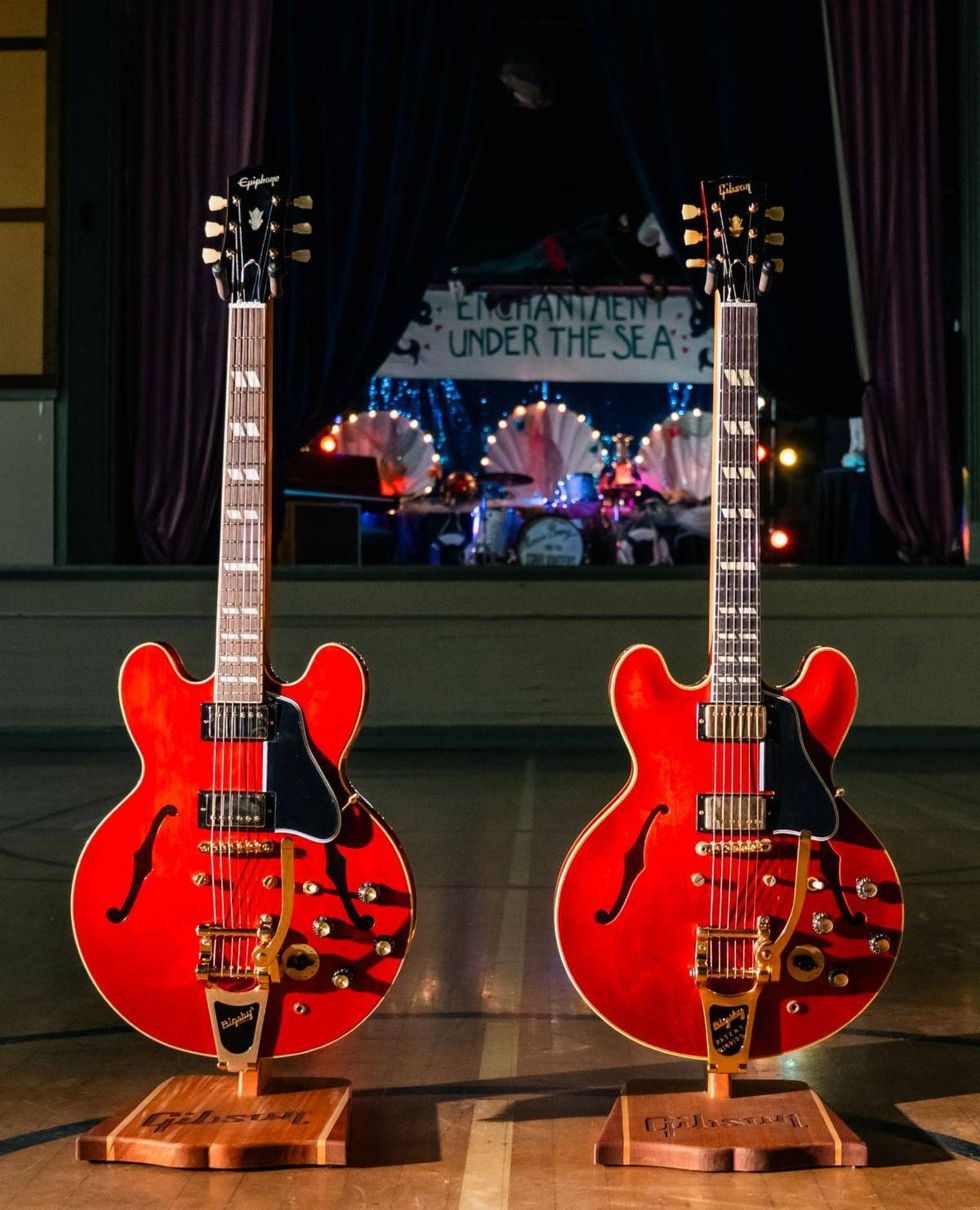
This summer, Gibson and Michael J. Fox launched a global “Lost to the Future” search for the original Gibson ES-345 Cherry Red guitar played by Fox in Back to the Future during the unforgettable “Enchantment Under the Sea” dance scene—a moment that inspired generations of musicians after Marty McFly’s electrifying performance of Chuck Berry’s “Johnny B. Goode.” Despite efforts to find the guitar during the filming of the sequel, the guitar’s whereabouts remained a mystery. Fans worldwide have been submitting tips at www.LostToTheFuture.com, and after thousands of submissions, Gibson has narrowed the search and is actively pursuing a handful of promising leads to locate and authenticate what may be the most significant guitar in movie history.
“Bringing this guitar to life has been a passion project for many years, and it’s incredibly exciting to finally see it become a reality,” says Mark Agnesi, Director of Brand Experience at Gibson. “We couldn’t be prouder of how these guitars turned out—they’re truly special. This is the guitar that inspired me, and countless others from my generation, to pick up playing in the first place.”
The Back to the Future 1955 ES-345 Collector’s Edition from Gibson Custom is limited to just 88 guitars worldwide, a nod to The Time Machine from the film, and features a stunning Cherry Red finish with exclusive design details. The Epiphone Back to the Future ES-345, limited to 1,985 guitars globally, celebrates the year the blockbuster film hit theaters and offers fans an accessible way to own a piece of cinematic and musical history. In addition to the guitars, there’s also an exclusive range of Back to the Future apparel and accessories, including tees, hats, collectible guitar pick tins, a guitar strap, and an AXE HEAVEN® mini guitar that will delight collectors and fans alike.
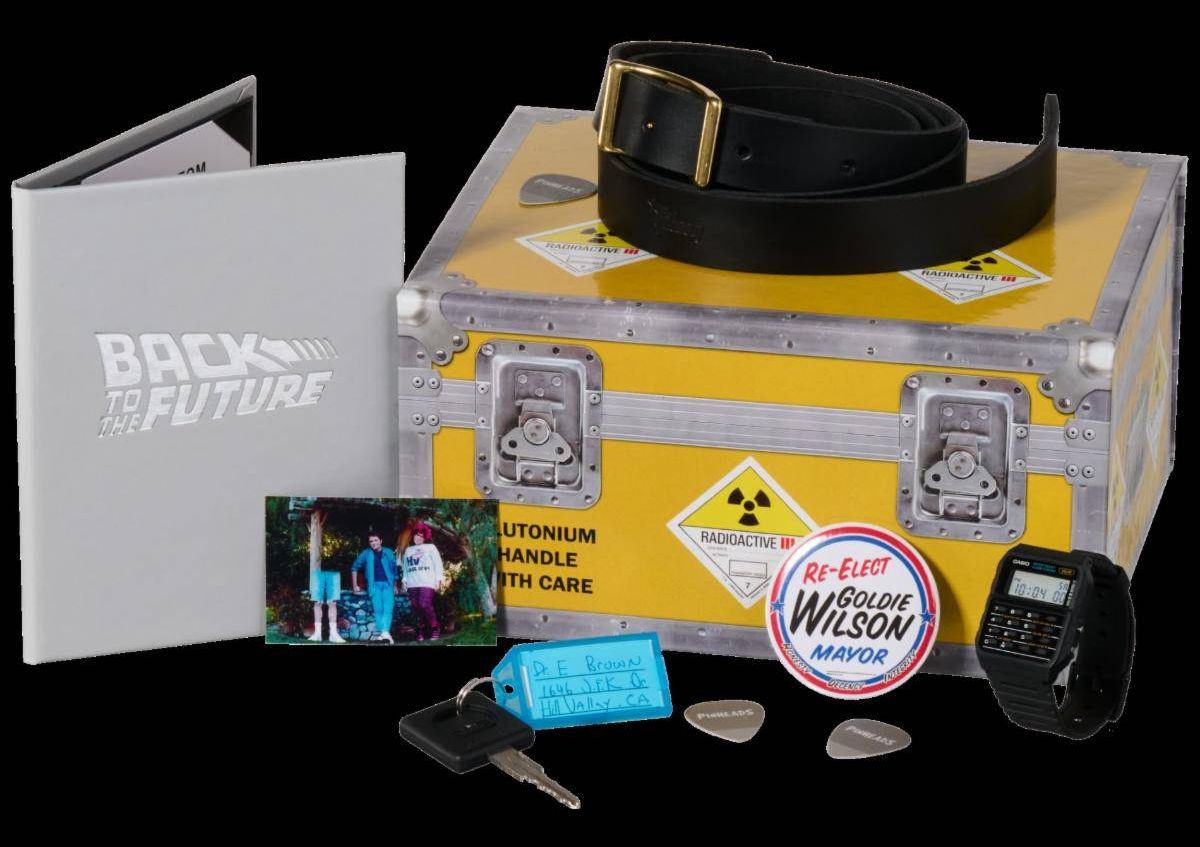
Back to the Future Gibson Custom Collection guitar case candy includes a flux capacitor, key to the Time Machine, a Casio watch, production still from the film, a guitar strap, picks, posters and a Certificate of Authenticity.
The new Epiphone Back to the Future ES-345 is a replica of the legendary Gibson ES-345 based on the model that Michael J. Fox aka Marty McFly plays in the film Back to the Future. A loving tribute to this cultural icon, the Epiphone Back to the Future ES-345 features a five-ply layered maple semi-hollowbody with a solid maple centerblock for enhanced sustain and improved feedback resistance. The top has four-ply binding with single-ply binding on the back. The mahogany neck has a comfortable Rounded C profile and is topped with a single-ply bound rosewood fretboard with 22 medium jumbo frets and is adorned with pearloid split parallelogram inlays that are a hallmark of the ES-345. The 60s Kalamazoo headstock is equipped with a Graph Tech® nut and Epiphone Deluxe tuning machines with cream Keyston buttons. The Epiphone logo and Gibson Crown are inlaid in mother of pearl. On the back of the headstock, in a nod to the 1985 film, you’ll find a Hill Valley Music store decal. The Back to the Future ES-345 has gold hardware, including an Epiphone LockTone™ Tune-O-Matic™ bridge and a Bigsby® B70 vibrato tailpiece, and just like the guitar in the movie, the original Stop Bar studs are left in place. The Back to the Future ES-345 is powered by two of Epiphone’s acclaimed Alnico Classic PRO™ pickups, each with individual volume and tone controls. A mono Varitone provides even more tonal versatility. It even comes packed in a vintage-style hardshell case with Marvin Berry and the Starlighters graphics. The Epiphone Back to the Future ES-345 is limited to only 1985 units worldwide, and they’re sure to go fast, so unless you have a flux capacitor-equipped Time Machine so that you can go back in time to get one later, you’d better grab yours now while you still can.

Launching alongside the Epiphone and Custom Shop ES-345 guitars, Gibson’s apparel division will release a collection of exclusive, film-inspired merchandise. Ranging from AXE Heaven mini ES-345 Cherry Red guitars to guitar pick tins, straps, T-shirts, and hats inspired by the film, the Back to the Future collection promises to be an exciting addition to any fans collection.
Way Huge Doom Hammer Review

Way Huge didn’t leave much to the imagination when it branded this fuzz the Doom Hammer. But that doesn’t mean it's without surprises. Jeorge Tripp’s latest design is based on an op-amp Big Muff that he modified for a client in the 1990s—primarily with the aim to tighten the low end. You hear Tripps hit that target when you play the Doom Hammer alongside other Big Muff types, which are massive in the low end and can sound comparatively sprawling in that frequency. But rather than merely heavy, the Doom Hammer’s combination of taut lows and the pronounced midrange one associates with op-amp Big Muffs is nasty, buzzy, punky, and brash. For all the desert-rock swagger in the name, the Doom Hammer is just as effective at lending contrast to heavy bass in a mix. And for any stoner rock power trio that has had to work against a wall of bottom-end sludge on stage or in the studio, it’s a practical and intriguing solution.
Fire Breather
Though it’s not hard to hear Big Muff lineage in the Doom Hammer, it can sound vastly different from most Muffs at identical fuzz, output, and tone levels. I didn’t have an op-amp Big Muff on hand for comparison, but in my experience with that circuit, I’ve found they have as much in common with other Big Muffs as they do differences. But Tripp’s recipe puts extra distance between them.
The Ram’s Head and Sovtek Muffs I used to A/B with the Doom Hammer, for instance, each exhibited the creaminess in low-midrange frequencies that makes David Gilmour obsessives ecstatic—particularly with the tone control at more modest levels. The Doom Hammer, however, sometimes has a buzz-saw aggressiveness that evokes a 1960s transistor fuzz swinging on a wrecking ball. And at low output and advanced fuzz levels it can quite convincingly play the part of Tone Bender. More modest fuzz and tone settings strike a more even balance between classic, buttery Big Muff sustain sounds and buzzier ones. And here it’s great for cooking up Carlos Santana and John McLaughlin’s questing lead tangles and Robert Fripp’s snaky synth-like lines. Indeed, the Doom Hammer, for all its midrange emphasis, can be flexible and adaptable.
The Doom Hammer, however, sometimes has a buzz-saw aggressiveness that evokes a 1960s transistor fuzz swinging on a wrecking ball.
Playing a bit more in the spirit of the Doom Hammer’s name (with an SG in drop-D, ’natch) I was still struck by how much less bossy it is in the bass range than a Ram’s Head or Sovtek. But again, this can be an ideal recipe for adding punchy contrast to the bass bomb coming from your bandmate’s Rickenbacker 4003 and Orange stack. It lends snarling aggression to big dumb rock riffs and drones, and detuned guitars sound less buried in blunted, washy overtones.
The Verdict
Jeorge Tripps’ knack for spinning new magic around fuzz formulas—whether with the wild Way Huge Atreides or the more straight-ahead Swollen Pickle—is a gift to fuzz freaks. Because, let’s face it, sometimes ferocious barrages of distortion can start to blur when ears are tired and you’re on the hunt for a different path. The Doom Hammer’s tight bass, and the resulting more prominent midrange, offer a discernibly different texture to work with, however, all while retaining the essential mass and menace that draws a player to a Big Muff in the first place.
Way Huge Doom Hammer Review
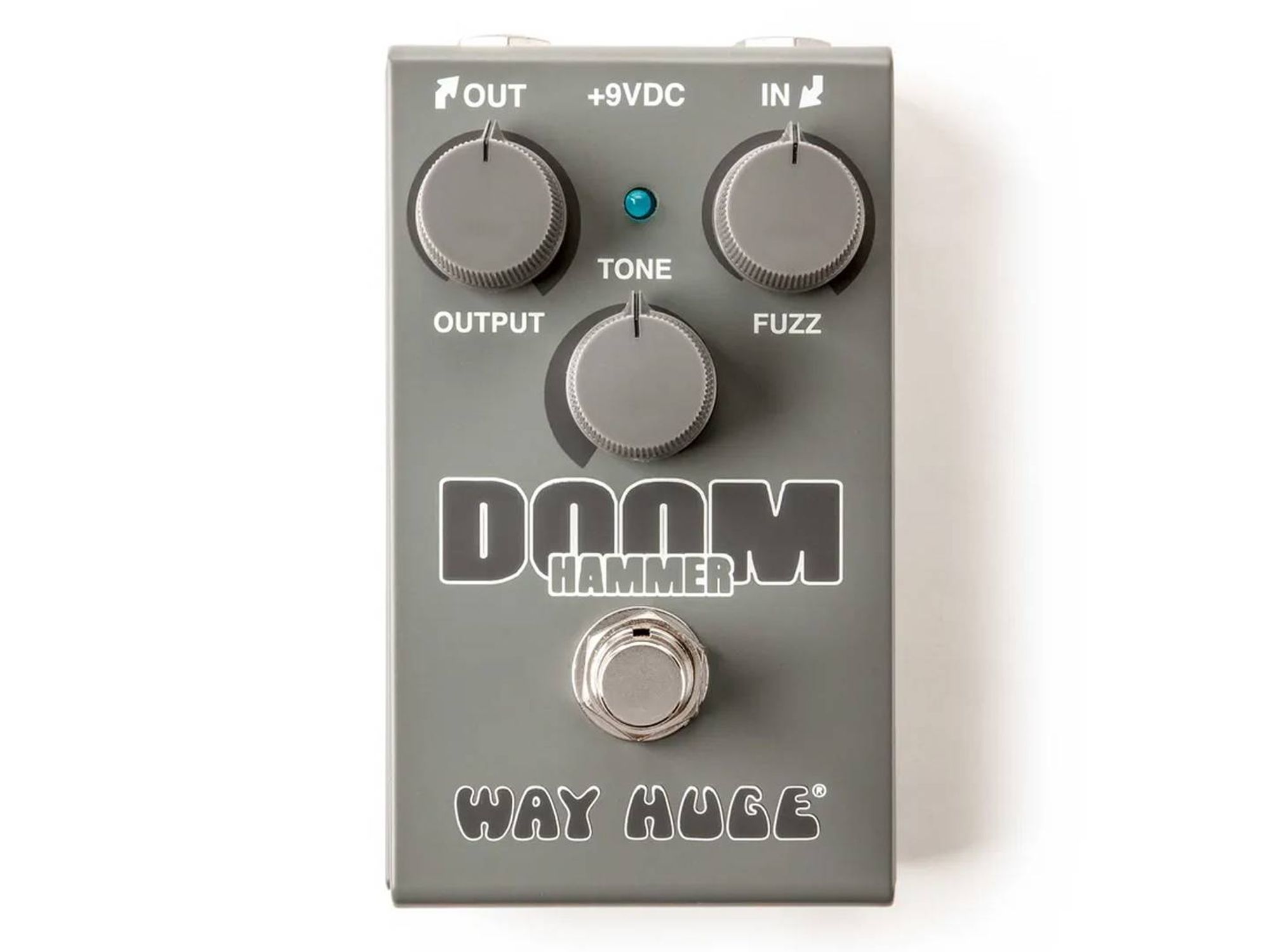
Way Huge didn’t leave much to the imagination when it branded this fuzz the Doom Hammer. But that doesn’t mean it's without surprises. Jeorge Tripp’s latest design is based on an op-amp Big Muff that he modified for a client in the 1990s—primarily with the aim to tighten the low end. You hear Tripps hit that target when you play the Doom Hammer alongside other Big Muff types, which are massive in the low end and can sound comparatively sprawling in that frequency. But rather than merely heavy, the Doom Hammer’s combination of taut lows and the pronounced midrange one associates with op-amp Big Muffs is nasty, buzzy, punky, and brash. For all the desert-rock swagger in the name, the Doom Hammer is just as effective at lending contrast to heavy bass in a mix. And for any stoner rock power trio that has had to work against a wall of bottom-end sludge on stage or in the studio, it’s a practical and intriguing solution.
Fire Breather
Though it’s not hard to hear Big Muff lineage in the Doom Hammer, it can sound vastly different from most Muffs at identical fuzz, output, and tone levels. I didn’t have an op-amp Big Muff on hand for comparison, but in my experience with that circuit, I’ve found they have as much in common with other Big Muffs as they do differences. But Tripp’s recipe puts extra distance between them.
The Ram’s Head and Sovtek Muffs I used to A/B with the Doom Hammer, for instance, each exhibited the creaminess in low-midrange frequencies that makes David Gilmour obsessives ecstatic—particularly with the tone control at more modest levels. The Doom Hammer, however, sometimes has a buzz-saw aggressiveness that evokes a 1960s transistor fuzz swinging on a wrecking ball. And at low output and advanced fuzz levels it can quite convincingly play the part of Tone Bender. More modest fuzz and tone settings strike a more even balance between classic, buttery Big Muff sustain sounds and buzzier ones. And here it’s great for cooking up Carlos Santana and John McLaughlin’s questing lead tangles and Robert Fripp’s snaky synth-like lines. Indeed, the Doom Hammer, for all its midrange emphasis, can be flexible and adaptable.
The Doom Hammer, however, sometimes has a buzz-saw aggressiveness that evokes a 1960s transistor fuzz swinging on a wrecking ball.
Playing a bit more in the spirit of the Doom Hammer’s name (with an SG in drop-D, ’natch) I was still struck by how much less bossy it is in the bass range than a Ram’s Head or Sovtek. But again, this can be an ideal recipe for adding punchy contrast to the bass bomb coming from your bandmate’s Rickenbacker 4003 and Orange stack. It lends snarling aggression to big dumb rock riffs and drones, and detuned guitars sound less buried in blunted, washy overtones.
The Verdict
Jeorge Tripps’ knack for spinning new magic around fuzz formulas—whether with the wild Way Huge Atreides or the more straight-ahead Swollen Pickle—is a gift to fuzz freaks. Because, let’s face it, sometimes ferocious barrages of distortion can start to blur when ears are tired and you’re on the hunt for a different path. The Doom Hammer’s tight bass, and the resulting more prominent midrange, offer a discernibly different texture to work with, however, all while retaining the essential mass and menace that draws a player to a Big Muff in the first place.
Demand has been so high for Rush’s reunion tour they’ve added 17 more dates

When Geddy Lee and Alex Lifeson announced Rush’s grand reunion earlier this month, its fair to say that fans ‘rushed’ to bag themselves some tickets; all of the tour dates instantly sold out. But don’t worry – Lee and Lifeson have announced 17 more dates.
Joining the now sold-out run of shows in Chicago, Cleveland, Fort Worth, Los Angeles, New York, and Toronto, Rush will also be performing in Atlanta, Boston, Philadelphia, and Washington D.C., to name a few.
- READ MORE: The guitar influences of Kurt Cobain
The Fifty Something 2026 tour will serve as the band’s official return to the stage after eleven years. As the name suggests, the tour is set to be a celebration of Rush’s 50+ years of music, as well as honouring the legacy of their legendary drummer, Neil Peart.
The tour will will be the first time Rush will perform together since 2015’s R40 tour, which was also the final time the late Peart was able to perform prior to his passing in 2020.
Alongside the new dates, Lee and Lifeson have shared a gracious video thanking their fans. After both uttering their own respective “WOW!”, Lee reflects on how “blown away” the pair feel about their initial announcement selling out. “I cannot tell you how [surprised] and overwhelmed we are,” he says.
Lee also takes a moment to thank fans for accepting their newest member, ex-Jeff Beck drummer, composer and producer Anika Nilles. “The way you guys have welcomed Anika Nilles into the Rush family has been very heart-warming,” he smiles. “I know she’s very appreciative of that and we’re even more excited to get back on stage with her and go through the plethora of songs that we’re planning!”
When first announcing the tour, Lee and Lifeson were keen to emphasise how the Fifty Something tour aims to honour Peart’s memory, and finding the right drummer was integral. “Life is full of surprises, and we have been introduced to another remarkable person; an incredible drummer and musician who is adding another chapter to our story while continuing her own fascinating musical journey,” they reflected.
“Her name is Anika Nilles, and we could not be more excited to introduce her to our loyal and dedicated Rush fanbase, whom, we know, will give her every chance to live up to that near impossible role… No small task, because as we all know Neil was irreplaceable.”
“Lerxst, Anika and myself, along with many of our longstanding crew members have been hard at work rehearsing and designing the kind of RUSH show you’ve grown accustomed to expect from us. We dearly hope you will come along and help us celebrate our history together.”
Peart’s family are also in support of the new era of the band, with both Peart’s daughter, Olivia Peart, and his wife, Carrie Nuttall, endorsing the tour in a statement: “We are thrilled to support the Fifty Something tour, celebrating a band whose music has resonated and inspired fans for generations, and to honour Neil’s extraordinary legacy as both a drummer and lyricist.”
“As the band enters this new chapter, it promises to be truly unforgettable. We are excited to see how their new vision unfolds, and to hear this legendary music played live once again.”
A presale for the newly added shows will be available for Ticketmaster members this Thursday (23 October) at 11:59pm ET. The Artist Presale begins on Monday (27 October).
The post Demand has been so high for Rush’s reunion tour they’ve added 17 more dates appeared first on Guitar.com | All Things Guitar.
Gibson’s Custom Shop recreation of the iconic Back to the Future ES-345 is finally here – alongside an affordable Epiphone version, too

A tease last week all but confirmed the imminent arrival of a production run version of the iconic Gibson ES-345 played by Marty McFly in Back to the Future’s famous school dance scene.
Now, coinciding with the 40th anniversary of the sci-fi cult classic, Gibson has officially unveiled the Custom Shop Back To The Future ES-345 Collector’s Edition – as well as a limited-edition Epiphone version for those with slightly more constrained pockets…
Back to the Future has been a heavy blip on Gibson’s radar in the past year after it launched a worldwide search – alongside the movie’s stars Michael J. Fox, Lea Thompson, Christopher Lloyd, Harry Waters Jr. and Huey Lewis – to track down the original ES-345 used in the movie.
At the time of writing, the search is still ongoing, but these new Custom Shop and Epiphone versions will have to do in the meantime.
 Credit: Gibson
Credit: Gibson
Famously, guitar gear nuts have long called out the historical inaccuracy of the Gibson ES-345’s inclusion in Back to the Future. The film’s iconic school dance scene is set in 1955, three years before the launch of the ES-345…
As the story goes, producers sourced the guitar from Norman’s Rare Guitars, and insisted on using it despite Norman Harris notifying them that the dates would be wrong. At the end of the day though, in a movie about time travel, do the dates really matter that much? Certainly not to Gibson, which has even named the new BTTF ES-345 the “1955 ES-345”, celebrating the inaccuracy in plain sight. We love to see it.
“During a high school dance in 1955, a Gibson guitar helped change the course of music history – and even rewrote history itself – in one unforgettable cinematic moment,” writes Gibson. “The ES-345 model featured in Back to the Future became an icon and bridged the past, present, and future in a way that only a great instrument can.”
There’s the background, but by now we’re sure you want to see some specs, and no doubt the price these guitars will set you back. We’ll get to that, but first…
Lightly aged by Gibson’s Murphy Lab, the Custom Shop Back to the Future ES-345 Collector’s Edition – and its corresponding Epiphone version – sport all the hallmarks of the original seen in the movie, including a Cherry Red finish, Bigsby B7 vibrato, gold hardware, varitone switch and 12th fret block inlay.
Further specs include a maple/poplar/maple three-ply body, thin D-shape mahogany neck and bound rosewood fingerboard with split parallelogram inlays, and a pair of Custombucker pickups. There’s also an ABR-1 No-Wire bridge and Kluson tuners. Also included are a Marvin Berry and the Starlighters-style hardshell case, certificate of authenticity, Enchantment Under the Sea poster and even a Flux Capacitor. We’re not sure if this works – you’ll have to try it out.
The Epiphone model does without the Murphy Lab treatment and Custombucker pickups, and swaps out the B7 Bigsby for a B70 Bigsby, instead.
“Bringing this guitar to life has been a passion project for many years, and it’s incredibly exciting to finally see it become a reality,” says Mark Agnesi, Director of Brand Experience at Gibson.
“We couldn’t be prouder of how these guitars turned out – they’re truly special. This is the guitar that inspired me, and countless others from my generation, to pick up playing in the first place.”
 Credit: Gibson
Credit: Gibson
Remember how we said we’d get to the price tag? Well, dig deep, as one of the Custom Shop Collector’s Edition Back to the Future ES-345s will set you back a not-insignificant £17,449. 88 are being made, corresponding with the 88 miles per hour required for time travel as per the laws of physics in the Back to the Future universe.
If nearly 20 grand sounds a little out of reach, the Epiphone version is priced at £949, with 1985 units being made – also the year the original movie was released.
Celebrating the release, Gibson has also launched a range of Back to the Future-branded merch, including T-shirts, pick tins, a guitar strap and more.
Learn more at Gibson.
The post Gibson’s Custom Shop recreation of the iconic Back to the Future ES-345 is finally here – alongside an affordable Epiphone version, too appeared first on Guitar.com | All Things Guitar.
Introducing The Reverend Reeves Gabrels Rg-Sus Mark II
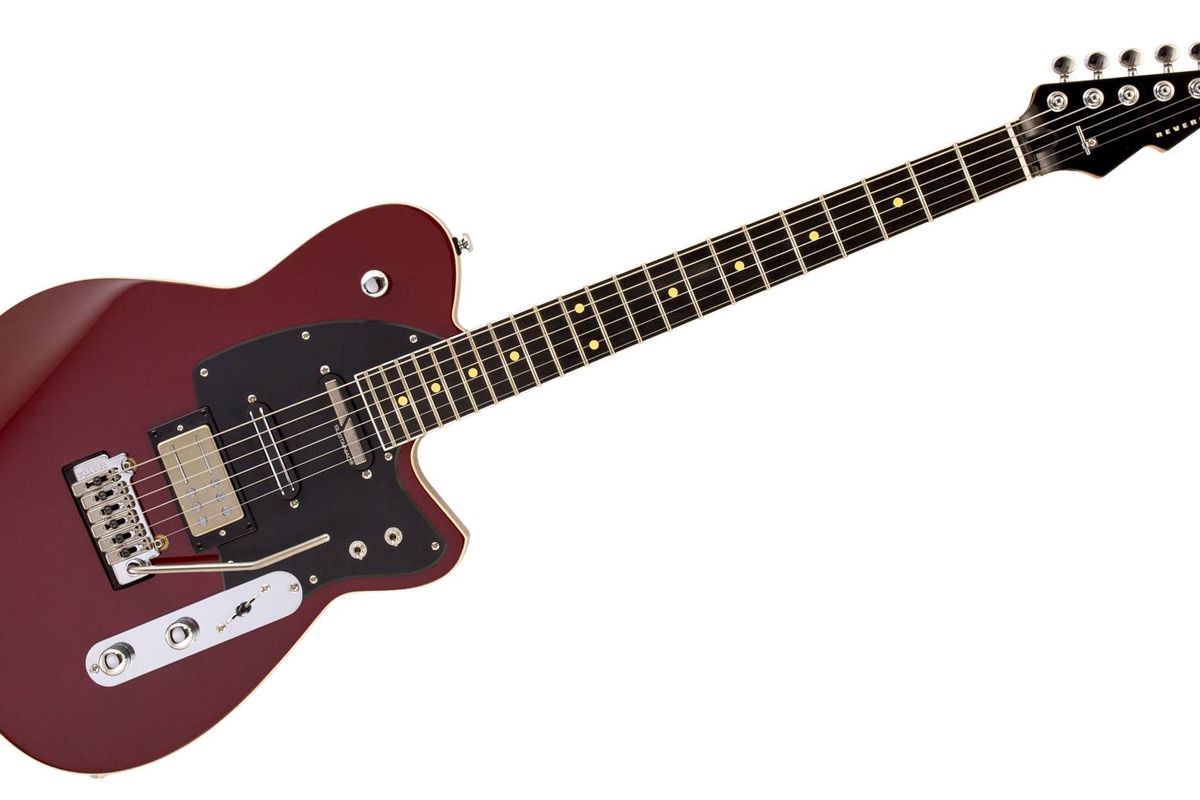
Introducing the Reverend Reeves Gabrels RG-SUS Mark II, reimagined with a new three-pickup layout. It features a 5-way selector for tone options galore. Fire up the acclaimed Sustainiac system for organic, controllable feedback and endless sustain. This system adds a whole new dimension to your playing, and it will pump up your creativity to a new level. If you’re a tone-shaping maniac, you need the Reeves Gabrels RG-SUS Mark II!
Reeves Gabrels has the unusual distinction of meeting David Bowie and forming a band with him – Tin Machine in 1989. He went on to work with Bowie in his solo career and a successful solo career of his own with his band Reeves Gabrels and His Imaginary Friends. He is currently the lead guitar player in The Cure, as well as involved with founding the project Gabrels/Kane/Parker-Wells.
The Reverend Reeves Gabrels RG-SUS Mark II is now available through any Reverend Authorized Dealer.
About Reverend Guitars:
Founded in 1997, Reverend Guitars has been at the forefront of creating instruments that are beyond the ordinary. With a commitment to quality, innovation, and the artistry of music, Reverend Guitars continues to inspire musicians worldwide. Each instrument is a testament to the brand's dedication to the craft, inviting players to explore new realms of sonic possibilities. Well played, indeed.
Gibson & Epiphone Honor Back to the Future's 40th Anniversary!
Turn back the clock, fire up the DeLorean, it's time to save the Hill County Courthouse & Clocktower. The only way to do that is to rock out with a cherry ES-345 like it's 1955!
These two players are doing so much to push guitar music forward Tim Henson has drafted them for the new Polyphia record

Back in 2013, a playthrough of Polyphia’s Impassion put the prog metal band on the map. The technical mastery at play instantly asserted guitarist Tim Henson as a young prodigy – and, 12 years on, Henson is keen to find the next wunderkind lurking in the shadows.
In a new interview with The Music Zoo, Henson reveals that he’s scouted a pair of up-and-coming guitarists to feature on Polyphia’s new record: RJ Pasin and Spiro Dussias. Considering Pasin’s intricate, videogame-soundtrack-worthy riffs and metal-infused hyperpop, and Spiro’s jawdropping shredding abilities, they’re sure to be a hit with Polyphia fans.
“We’ve brought them in for the Polyphia record, and it is insane – it is such a crazy sound!” Henson explains. “RJ Pasin can shred, and he can do all these [cool] things. And then, through working with [Spiro], I’ve rethought the way that I play.”
In terms of Spiro, Henson praises the gold-star shredder for his economy picking in particular. “One of the things that Spiro really tries for with his playing is, like, how easy can he make it?” he says. “He told me he wants to be an old guy who has no problem just [shredding], and it’s his approach to the economics of motion.”
“I learned economy picking when I was pretty young,” he continues. “And then you see players like Tosin Abasi who take that shit to the next level… then somebody like Spiro comes in, and just takes it up a whole other notch!”
It’s not the first time Henson has publicly praised Spiro. Back in February, the guitarist named Spiro as the next big guitar talent to watch out for. “That guy is fucking crazy,” he told Guitar World. “I’m definitely going to be hitting him up to see what kind of insanity he can bring [to the new record].”
While Henson’s background in classical violin has helped him forge his own unique style, he’s still keen to learn from the young prodigies of tomorrow. He points to Polish star Marcin Patrzałek’s insane percussive fingerstyle techniques and Italian jazz rocker Matteo Mancuso as examples. “They’re taking guitar to new heights,” he insists.
While Polyphia didn’t collaborate with Patrzałek on their upcoming record, Patrzałek has also shone a spotlight on one of Henson’s up-and-coming collaborators this year. The guitarist notably collaborated with RJ Pasin back in July… Small world!
“Every day, we continue to have absolute sicko monster players coming out,” he says. “It’s just getting crazier and crazier and crazier – and it’s awesome… Like, there’s Marcin, and all these other kids that are just absolutely incredible! They just play circles around me!”
“It’s cool, because, this late in the game, I’m so fortunate to feel inspired [by] my peers,” he reflects.
Elsewhere on the new record, Henson has also teased that there will be a collaborative track with System of a Down’s Serj Tankian. “The new record… it’s heavy!” he teased in conversation with Guitar World.
Check out Henson’s full chat with The Music Zoo below.
The post These two players are doing so much to push guitar music forward Tim Henson has drafted them for the new Polyphia record appeared first on Guitar.com | All Things Guitar.

